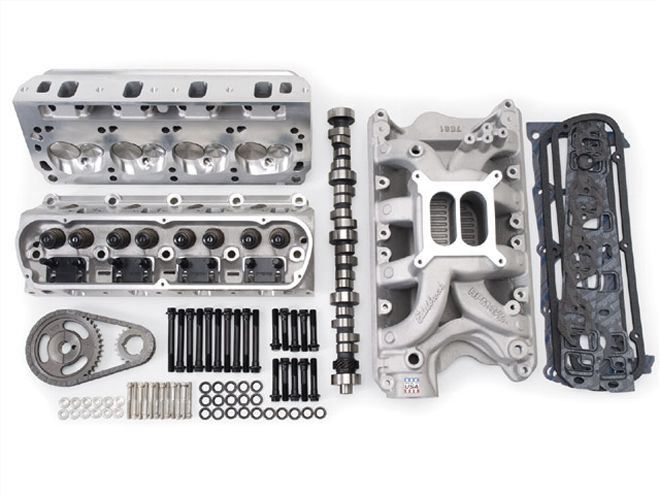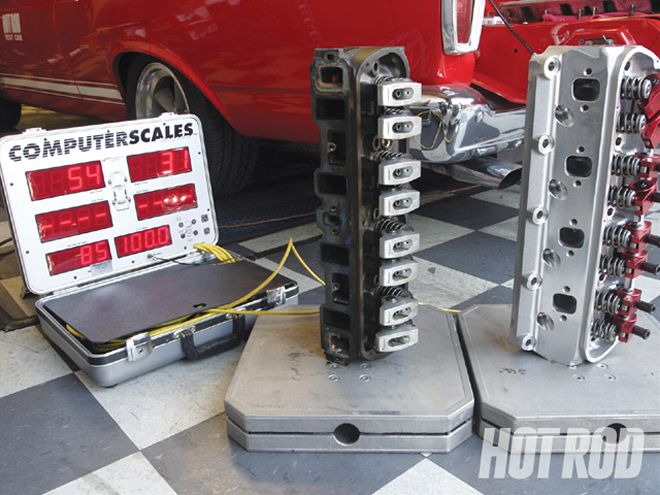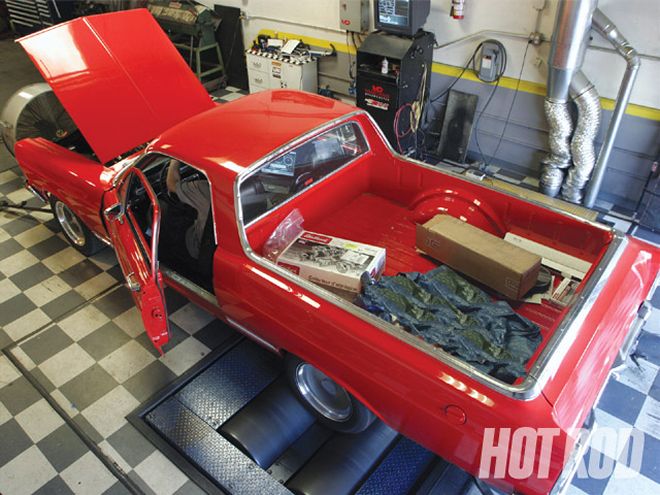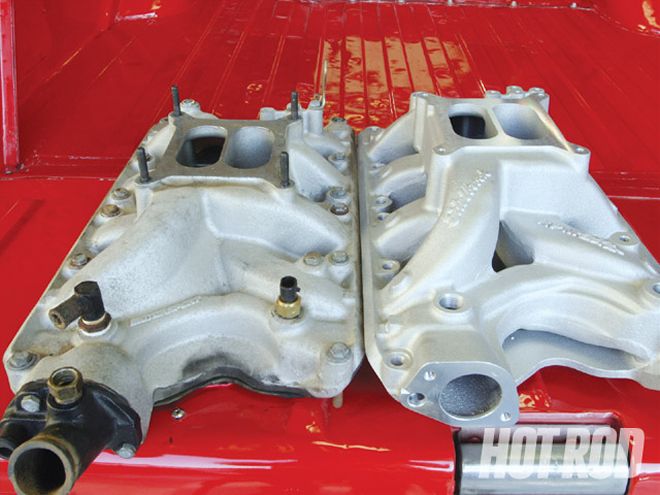
 One of the best parts about Edelbrock's Top End kits is you won't find yourself making parts store runs mid-swap. Everything needed is supplied in the PN 2090 kit for $2,583.69.
One of the best parts about Edelbrock's Top End kits is you won't find yourself making parts store runs mid-swap. Everything needed is supplied in the PN 2090 kit for $2,583.69.
While performing EFI dyno testing on our '67 Ranchero with the Powerjection system from Professional Products (Nov. '08), we noted that the little $2,000 351W made respectable power with good torque numbers despite being composed mainly of stock Ford parts from various generations. However, it began to run out of steam earlier than we had anticipated. The dyno chart showed that it pulled strong until about 4,400 rpm before peaking at 4,600 and running out of breath. Considering our Crane roller conversion cam featured 0.525/0.542 valve lift with 212/220 duration at 0.050, we were expecting numbers to peak somewhere in the 5,000- to 5,500-rpm range. With an easy 7,000 miles on the long-block, we knew wear wasn't to blame. Our gut reaction was to lay fault on the tiny valves in the GT-40P cylinder heads that were designed to give 5.0 Explorers some low-end kick, not help cammed 5.8s breathe on the top end.
Our search for the right set of heads to wake up the potential in this Windsor coincided with the release of Edelbrock's new Performer RPM XT cylinder heads for the 351W. Edelbrock's standard Performer RPM heads have been excellent upgrades, but there's always room for improvement, and a little time on the CNC machine can make them better. The new XT, or Extreme, cylinder heads offer what Edelbrock refers to as partial CNC. The intake entry and exhaust exit are profiled, the intake and exhaust bowls are blended, and the combustion chambers get a full port job. All those little touches add up to impressive flow numbers. With a revised 18-degree valve angle (versus 20 stock) to reduce shrouding in the combustion chamber and allow for a slightly smaller combustion chamber to increase static compression (59 cc versus 60 cc in standard Performer RPM heads), these heads have the potential of producing big numbers when mixed with the right package.
That's where the new Top End kit comes in. To complement the new heads' capabilities, Edelbrock has bundled together Power Package PN 2090, which provides a set of Performer RPM XT cylinder heads, a Rollin' Thunder Performer RPM hydraulic roller cam, a Performer RPM Air-Gap intake, a Performer Link timing set, ARP head bolts, and all the necessary gaskets. Basically, that one part number should transform our Windsor from perky to powerful in one thrash session.
But since all the Top End kit parts are available separately as well, rather than throw the whole shebang on our Windsor at once, we'll upgrade one part at a time to evaluate its performance when paired with our previously installed components. The aforementioned Powerjection EFI will be the induction for all the testing. To help us out with the in-car parts swapping, we enlisted Pete Andreas at W.O.T. Performance. Andreas runs two road racers in the American Stock Car Challenge (ASC) in his spare time, and W.O.T. Performance is the official dyno testing facility for the series. His 351-powered Taurus and ZZ4 350-powered Monte Carlo are currently two of the top cars in the series. He can also swap Windsor heads and cams with his eyes closed. We took our time and spent a couple of days on the dyno, but the total top-end swap could easily be performed with a good day's worth of wrenching.
Performer Rpm Xt Cylinder Head Specs
Combustion chamber: 59 cc
Intake runner volume: 185 cc
Exhaust runner volume: 75 cc
Intake/exhaust valve: 2.02 inches/1.57 inches
Beehive valvespring: 1.540-inch od 1.900-inch installed height
Rocker stud/guideplate: 7/16-inch/hardened steel
Cam Specs
Crane
Type: hydraulic roller
Lobe separation: 112
Duration intake/exhaust at 0.006 inch: 274/282
Duration intake/exhaust at 0.050 inch: 212/220
Intake opens/closes: 26 BTDC 68ABDC
Exhaust opens/closes: 74 BBDC 28ATDC
Valve lift (1.6 rockers) intake/exhaust: 0.525/0.542 inch
 Since Pete Andreas keeps a set of scales around for setting up track cars, we dropped the heads on the pads for a weight comparison. We'll be taking a solid 46 pounds off the nose of our Ranchero.
Since Pete Andreas keeps a set of scales around for setting up track cars, we dropped the heads on the pads for a weight comparison. We'll be taking a solid 46 pounds off the nose of our Ranchero.
Edelbrock
Type: hydraulic roller
Lobe separation: 112
Duration intake/exhaust at 0.006 inch: 299/302
Duration intake/exhaust at 0.050 inch: 235/238
Intake opens/closes: 11 BTDC/44 BTDC
Exhaust opens/closes: 56 BBDC/2 ATDC
Valve lift (1.6 rockers) intake/exhaust: 0.573/0.582 inch
Stage 1
Performer RPM XT cylinder heads
Comp Cams 7/16 1.6 aluminum roller rockers
Cylinder head bolt set
We decided to begin with just the XT cylinder heads to determine whether our Windsor really was suffering from a lack of airflow through the GT-40P heads. There were some initial concerns over valve clearance, since we were unsure how much dish was in our decade-old hypereutectic pistons. A little clay pressed on the piston while we rotated the engine revealed that we had plenty of depth to our dish. And while the radial clearance around the eyebrow of the dish was tight, we were still in the safe zone without fly-cutting.
On the dyno we saw a notable drop in torque below 3,400 with the XT heads, but they bested the peak value at the same rpm and held more torque at higher rpm. There was a slight horsepower drop below 3,400, but the 351 was still climbing and making power after 4,600 for the first time and found an additional 18 peak horsepower at the wheels. That's noticeable. The lesson to take away here, as stated by Andreas, is "Where do you want your power?" Our small-valved GT-40Ps choke top end power, but they work well to create bottom-end torque. By comparison, the large-valved Edelbrock XTs are doing exactly as they're designed to do, giving us the top-end pull we lacked and increasing horsepower.
FLOW DATA: GT-40P VS. EDELBROCK HEAD GT-40P EDELBROCK VALVE 1.84 1.46 2.02 1.{{{57}}} LIFT INTAKE EXHAUST INTAKE EXHAUST 0.{{{100}}} 54 46 78 63 0.{{{200}}} 118 93 146 119 0.{{{300}}} 158 115 213 173 0.400 183 123 257 197 0.500 185 126 281 205 0.600 N/A N/A 292 209 BASELINE DYNO NUMBERS* RPM LB-FT HP 3,000 279.17 161.85 3,200 290.47 184.28 3,400 300.11 194.74 3,600 301.42 207.07 3,800 308.45 219.94 4,000 301.54 230.60 4,200 297.24 238.30 4,400 291.06 244.52 4,600 284.95 249.36 4,800 270.81 247.68 5,000 255.85 245.25 5,200 242.54 {{{240}}}.36 5,300 234.58 236.86 Just as it learned what our original package wanted, our Powerjection EFI system had no issues adapting to the airflow demands of the Edelbrock heads and intake. We monitored the system outputs through the dashboard software, but no manual tuning was necessary.
Just as it learned what our original package wanted, our Powerjection EFI system had no issues adapting to the airflow demands of the Edelbrock heads and intake. We monitored the system outputs through the dashboard software, but no manual tuning was necessary.
*It should be noted that all dyno tests were run on a Mustang MD600hp chassis dyno utilizing DynoJet calibration, which typically delivers roughly 10 to 12 percent lower numbers than the SuperFlow dyno used for the EFI conversion story. We did not lose horsepower; we're just extrapolating the values differently. The gains will be the same regardless.
DYNO RESULTS STAGE 1 RPM LB-FT HP 3,000 270.79 156.08 3,{{{200}}} 289.21 176.33 3,400 296.95 192.75 3,{{{600}}} 305.12 208.68 3,800 309.00 224.09 4,000 305.10 232.72 4,200 296.86 238.00 4,400 296.83 246.01 4,600 289.30 252.44 4,800 287.87 259.21 5,000 277.89 265.03 5,200 270.06 267.00 5,400 261.27 267.83Stage 1 Total:
HP: 267.83
LB-FT: 309.00
Gain: 18.47 hp, 0.55 lb-ft
 Despite the 18-degree valve angle, the XT heads retain the factory angle on the intake ports, so a standard 351 RPM Air-Gap (right) fits. Though they're very similar in construction, the Air-Gap has slightly longer raised runners along with a larger cross-sectional area and a taller carb flange, which combined make it about 1 inch taller than our Ford Motorsport intake or a standard Performer RPM.
Despite the 18-degree valve angle, the XT heads retain the factory angle on the intake ports, so a standard 351 RPM Air-Gap (right) fits. Though they're very similar in construction, the Air-Gap has slightly longer raised runners along with a larger cross-sectional area and a taller carb flange, which combined make it about 1 inch taller than our Ford Motorsport intake or a standard Performer RPM.
Stage 2
Performer RPM Air-Gap intake
As well as the XT heads flow, their potential can be hampered by being paired with the wrong intake. Our Motorsport intake was an excellent choice for the rpm range our GT-40P heads were effective in, but we bet that the Performer RPM Air-Gap manifold would work better and were not surprised when it recovered all the lost low-end and torque and then some while gaining significantly on the top end, too.
Stage 3
Performer RPM
hydraulic roller cam
Performer Link timing set
Edelbrock hydraulic roller lifters
The final step to complete the Edelbrock kit is swapping in the Rollin' Thunder Performer RPM cam with Edelbrock's linked lifter and pushrod kit. Had our engine been equipped with a standard roller cam, this would be a simple swap, but the Crane retrofit kit utilizes a small-base-circle cam paired with stock-style Ford roller lifters to help cut down on cost to consumers. As such, we had to upgrade to linked-style lifters and decrease our pushrod length. Luckily, Edelbrock also has that sorted out for you and has a package available in addition to the Top End kits.
With nearly 0.050 more lift on the intake and 0.040 on the exhaust and significantly more duration, we were expecting a healthy increase in horsepower, and above 3,800 that's exactly what we got. Below that point, however, we did have a loss of power, which is the trade-off to be expected as we shifted our power curve upward 300 rpm to peak at 5,700. The total output is less than we had hoped for, but we did add 54 rear-wheel horsepower and 1,100 rpm to our engine's range.
Stage 3 Total:
HP: 303.29
LB-FT: 326.25
Gain: 22.03 hp, 4.46 lb-ft
Total Gain: 54.29 hp, 17.80 lb-ft HRM